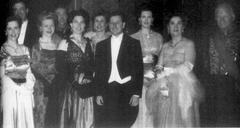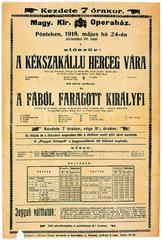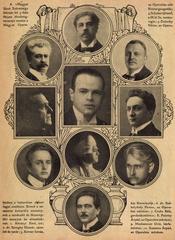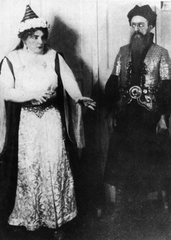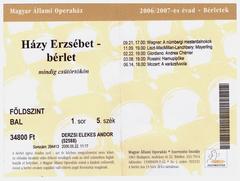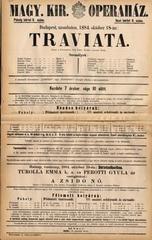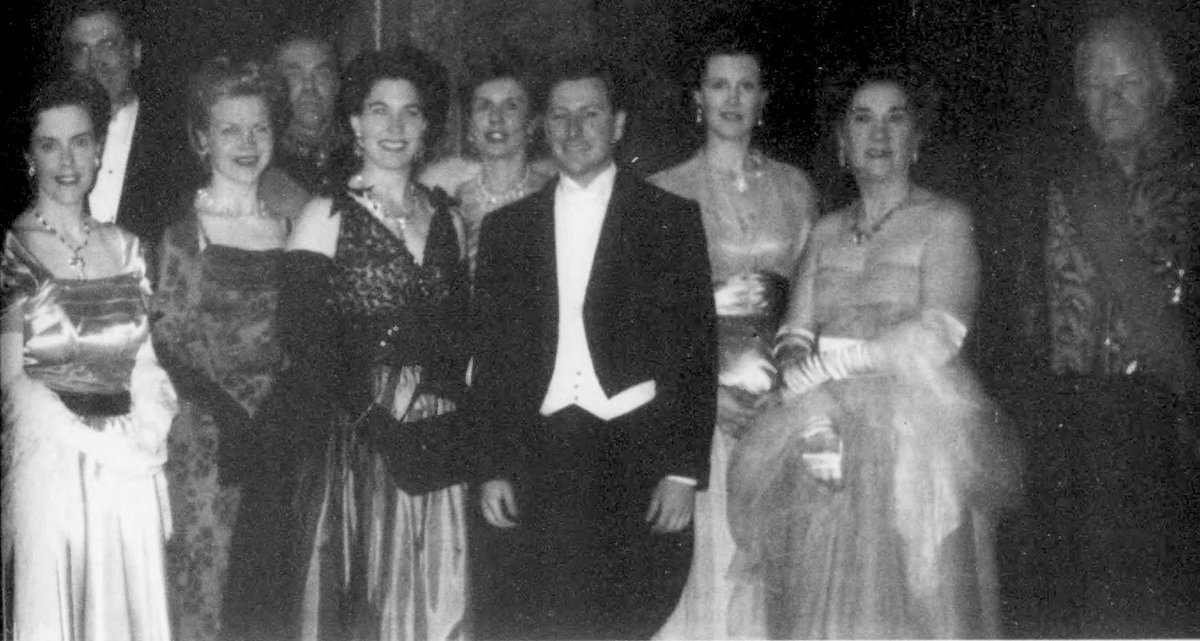
Hungarian State Opera House Budapest: Visiting Hours, Tickets, and Complete Visitor Guide
Date: 14/06/2025
Introduction
The Hungarian State Opera House stands as a magnificent jewel in the heart of Budapest, captivating visitors with its grand neo-Renaissance architecture, storied history, and world-class performances. Since its inauguration in 1884, this landmark has played a vital role in Hungary’s cultural life, both as a beacon of musical excellence and as a symbol of national pride. Located on the elegant Andrássy Avenue—a UNESCO World Heritage Site—the Opera House offers not only exceptional acoustics and breathtaking interiors but also convenient access to many of Budapest’s most celebrated attractions. Whether you’re an opera lover, architecture enthusiast, or a traveler eager to explore Budapest’s heritage, this guide provides everything you need to plan your visit, including information on history, architecture, performances, tours, accessibility, and nearby sights (opera.hu, budapest-travel-tips.com, budapest.com).
Table of Contents
- Introduction
- History and Origins
- Architectural Highlights
- Inauguration and Early Years
- Notable Directors and Cultural Events
- Renovations and Modernization
- Visitor Information
- Nearby Attractions
- Special Events and Festivals
- Frequently Asked Questions (FAQ)
- Conclusion
- References
History and Origins
The Hungarian State Opera House, originally the Hungarian Royal Opera House, was envisioned as Budapest’s premier opera venue in the late 19th century, when the city’s cultural ambitions soared alongside its population growth. Prior to its construction, opera had been performed at the National Theatre, which no longer satisfied technical or artistic needs (opera.hu). In 1873, a design competition was held, which was won by the renowned architect Miklós Ybl, whose neo-Renaissance plans perfectly captured the grandeur and aspirations of the era. Construction began in 1875, supported by both the city of Budapest and Emperor Franz Joseph I, who stipulated that the building should not surpass the Vienna State Opera in size, but Ybl ensured it would rival any European opera house in beauty and acoustics.
Architectural Highlights
Exterior and Façade
The Opera House’s symmetrical façade, facing Andrássy Avenue, is adorned with statues of Hungarian composers Ferenc Erkel and Franz Liszt, crafted by Alajos Stróbl (budapest-travel-tips.com). Elaborate stone carvings, Corinthian columns, and a central dome combine neo-Renaissance and Baroque elements. The use of local limestone and marble roots the building in Hungarian tradition, while decorative urns and statuary add to its grandeur.
Grand Staircase and Foyer
Upon entering, visitors are greeted by a sweeping double staircase made of Carrara marble, illuminated by ornate chandeliers and stained glass. The foyer’s mosaic floors and frescoes, painted by Károly Lotz and Mór Than, depict mythological and allegorical scenes, setting a majestic tone for the visit.
Auditorium and Acoustics
The horseshoe-shaped auditorium seats 1,261 guests and is renowned for its exceptional acoustics, considered among the best in Europe (wikipedia). The ceiling fresco by Lotz depicts the gods of Olympus, centered around a massive 3,050 kg bronze chandelier. Luxurious red velvet, gilded stucco, and intricate woodwork create an opulent environment for performances.
Royal Box and Loges
The royal box, centrally located, is lavishly decorated with gold leaf and velvet, a testament to the prestige of the venue. Private loges, each with distinct motifs, reflect the tastes of their original patrons and offer intimate viewing spaces.
Stage and Backstage
The stage, one of the largest in Europe, was modernized during the 2017–2022 renovation, now equipped with advanced stage machinery and a spacious orchestra pit for up to 100 musicians. These updates allow for modern productions while preserving the historic character (budapest-travel-tips.com).
Decorative Arts and Lighting
Frescoes, sculptures, and murals throughout the building narrate musical and historical themes. The main chandelier, adorned with crystal prisms, dominates the auditorium, while stained glass windows and additional bronze fixtures create a warm, dramatic ambiance.
Inauguration and Early Years
The Opera House opened on September 27, 1884, with Emperor Franz Joseph I in attendance. The inaugural program featured compositions by Erkel and Wagner, establishing the venue as Hungary’s musical epicenter. From the outset, it staged dozens of operas and hundreds of performances annually, contributing to Hungary’s cultural renaissance (wikipedia).
Notable Directors and Cultural Events
Ferenc Erkel, the first director, set artistic standards that have endured for generations. Later, Gustav Mahler and Otto Klemperer further elevated the Opera House’s international reputation. The annual Budapest Opera Ball, inaugurated in 1886, remains a glamorous highlight of the city’s social calendar (wikipedia).
Renovations and Modernization
Major renovations in the 1980s and the comprehensive 2017–2022 restoration have preserved the Opera House’s historic features while updating technical systems and audience amenities. Architect Gábor Zoboki’s recent renovation improved acoustics, comfort, and stage technology, ensuring the Opera House maintains its world-class status (budapest-travel-tips.com).
Visitor Information
Visiting Hours
- Guided Tours: Typically available Tuesday to Sunday, 10:00 AM–5:00 PM. English tours are often held at 1:30 PM, 3:00 PM, and 4:30 PM. Check the official website for updates, especially during holidays and special events.
- Box Office: Generally open 10:00 AM–6:00 PM.
Tickets and Tours
- Performance Tickets: Prices vary by production and seat category, with discounts for students, seniors, and groups. Advance booking is highly recommended (budapest.net).
- Guided Tours: Approximately €26 (9,000 HUF), available in multiple languages. Tickets can be purchased online or at the box office (jegy.opera.hu).
Accessibility
The Opera House is fully accessible, with ramps, elevators, and reserved seating for visitors with disabilities. Notify staff in advance to arrange assistance (budapest.com).
Getting There
- Metro: Line M1 (Opera station).
- Bus: Lines 105, 15, 210B, 9.
- Tram: Lines 4 and 6 (Oktogon stop is a short walk).
- Address: 22 Andrássy Avenue, Budapest, 1061.
Visitor Tips
- Book early for performances and tours, especially during peak seasons.
- Arrive at least 30 minutes before performances.
- Photography is permitted during tours but not during performances.
- Dress code: Smart attire is advised for performances; no formal dress required for tours.
- Language: English is widely spoken by staff; tours are available in several languages.
Nearby Attractions
- St. Stephen’s Basilica: Imposing neoclassical church with observation deck and concerts (yourcitybudapest.com).
- Andrássy Avenue: A grand boulevard lined with historic mansions, luxury shops, and cafés (budappest.com).
- Budapest City Park (Városliget): Home to Széchenyi Thermal Bath, Budapest Zoo, and Vajdahunyad Castle (yourcitybudapest.com).
- House of Terror Museum: Exhibits on Hungary’s 20th-century history (budapest.city).
- Liszt Ferenc Square: Lively dining and music scene, near the Liszt Academy of Music (yourcitybudapest.com).
- Dohány Street Synagogue: Europe’s largest synagogue and Jewish heritage center (budapest.city).
- Hungarian Parliament Building: Iconic riverside landmark, guided tours available (alle.travel).
- Buda Castle District: UNESCO site with palaces, museums, and city views (alle.travel).
Special Events and Festivals
- Budapest Opera Ball: Annual gala with live music and dance, held since 1886 (budappest.com).
- Operas, Ballets, and Concerts: Year-round performances, including highlights like La Traviata, Macbeth, and Le nozze di Figaro (Operabase).
- Festivals: The Opera House participates in the Budapest Spring Festival and CAFe Budapest Contemporary Arts Festival.
- Special Tours and Family Programs: Educational events and behind-the-scenes access, especially during school holidays.
Frequently Asked Questions (FAQ)
Q: What are the opening hours for tours and ticket sales?
A: Tours are generally available Tuesday to Sunday, 10:00 AM–5:00 PM; the box office is open 10:00 AM–6:00 PM. Check the official website for current schedules.
Q: How can I purchase tickets?
A: Buy tickets online via the official ticketing site or at the box office. Early reservations are recommended.
Q: Is the Opera House accessible for people with disabilities?
A: Yes, with ramps, elevators, and reserved seating. Contact staff in advance for assistance.
Q: Are guided tours offered in multiple languages?
A: Yes, tours are conducted in English and several other languages.
Q: What attractions are nearby?
A: St. Stephen’s Basilica, Andrássy Avenue, City Park, the House of Terror Museum, and more.
Q: Can I take photos inside the Opera House?
A: Photography is allowed during guided tours but not during live performances.
Conclusion
The Hungarian State Opera House encapsulates the artistic and cultural spirit of Budapest, offering visitors an unparalleled blend of history, architecture, and music. From its grand marble staircase and gilded interiors to its roster of celebrated performances, each visit promises a journey through Hungary’s artistic legacy. Situated at the center of a vibrant cultural district, the Opera House is a gateway to exploring Budapest’s most iconic attractions. To make the most of your experience, book tickets in advance, consider joining a guided tour, and explore the surrounding sights. For up-to-date schedules, exclusive insights, and travel tips, use the Audiala app and follow our social media channels.
References
- Hungarian State Opera House Official Site
- Wikipedia: Hungarian State Opera House
- Budapest Travel Tips: Opera House
- Budapest.com: Hungarian State Opera House
- Budapest.net: Opera House Info
- Operabase: Hungarian State Opera
- Official Ticketing Site
- Budapest Opera Tickets: Venue Info
- Budapest.city: Attractions
- Your City Budapest: Attractions
- Alle Travel: Budapest Sights
